Abstract
A retrospective population-based case-control interview study has been conducted in three distinct areas in the north of England where local excesses of children with leukaemia have been reported. A total of 109 cases of childhood (0-14 years at diagnosis) leukaemia and non-Hodgkin's lymphoma who were born in one of the study areas and diagnosed there between 1974 and 1988 were included in the study. One control per case was matched on sex, date-of-birth and health district of birth. The objective was to compare residential histories of cases and controls and in particular to determine whether case children had lived in the same place at the same time more often than controls. The residential distance between two children was taken to be the smallest geographical distance between homes they had 'occupied' simultaneously for a period of at least 6 months between conception and diagnosis. Case children were more likely than expected to have other cases as their nearest neighbours by residential distance (observed = 69, expected = 54.5, P = 0.006). A detailed examination of the nearest neighbour pattern permits the generation of further specific hypotheses. These suggest that persistent infection established in utero or early infancy may be involved in the development of some cases of childhood leukaemia. Horizontal transmission of the agent(s) within small communities may occur but there is no evidence of direct contact between cases.
Full text
PDF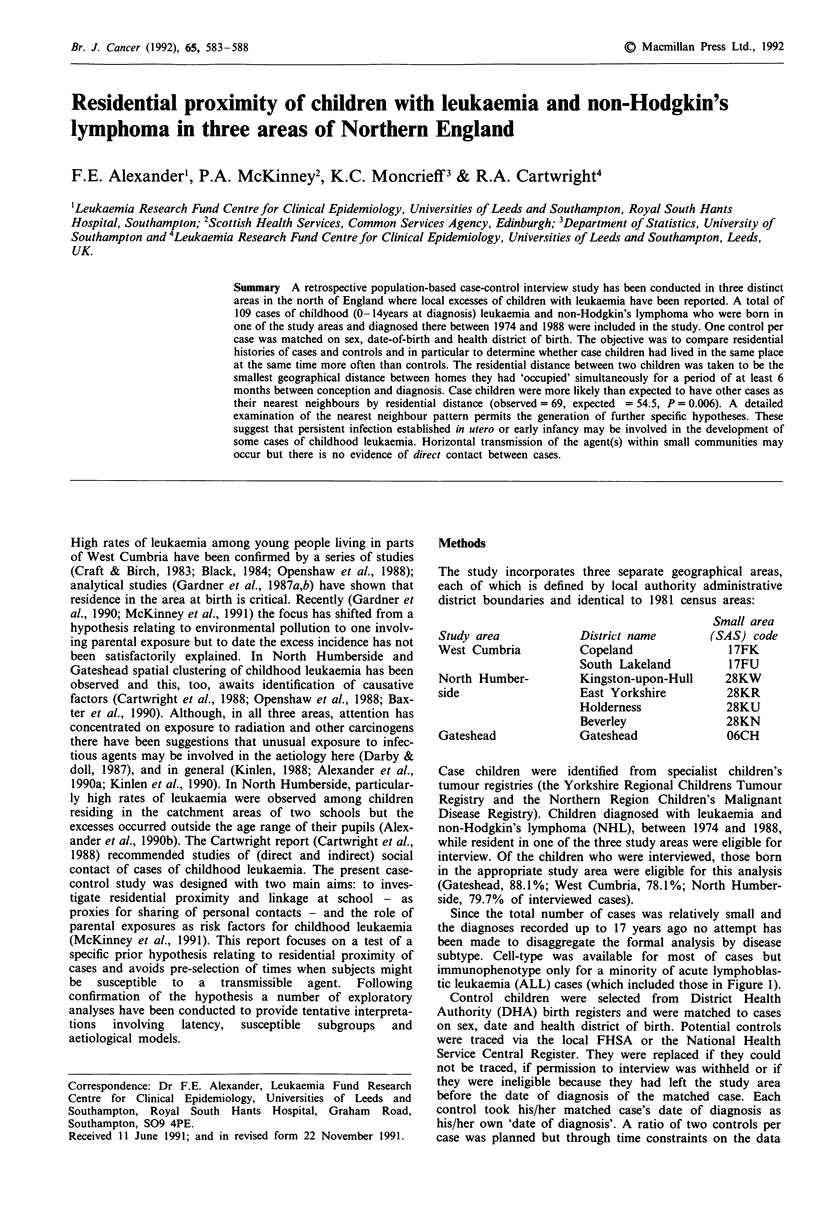
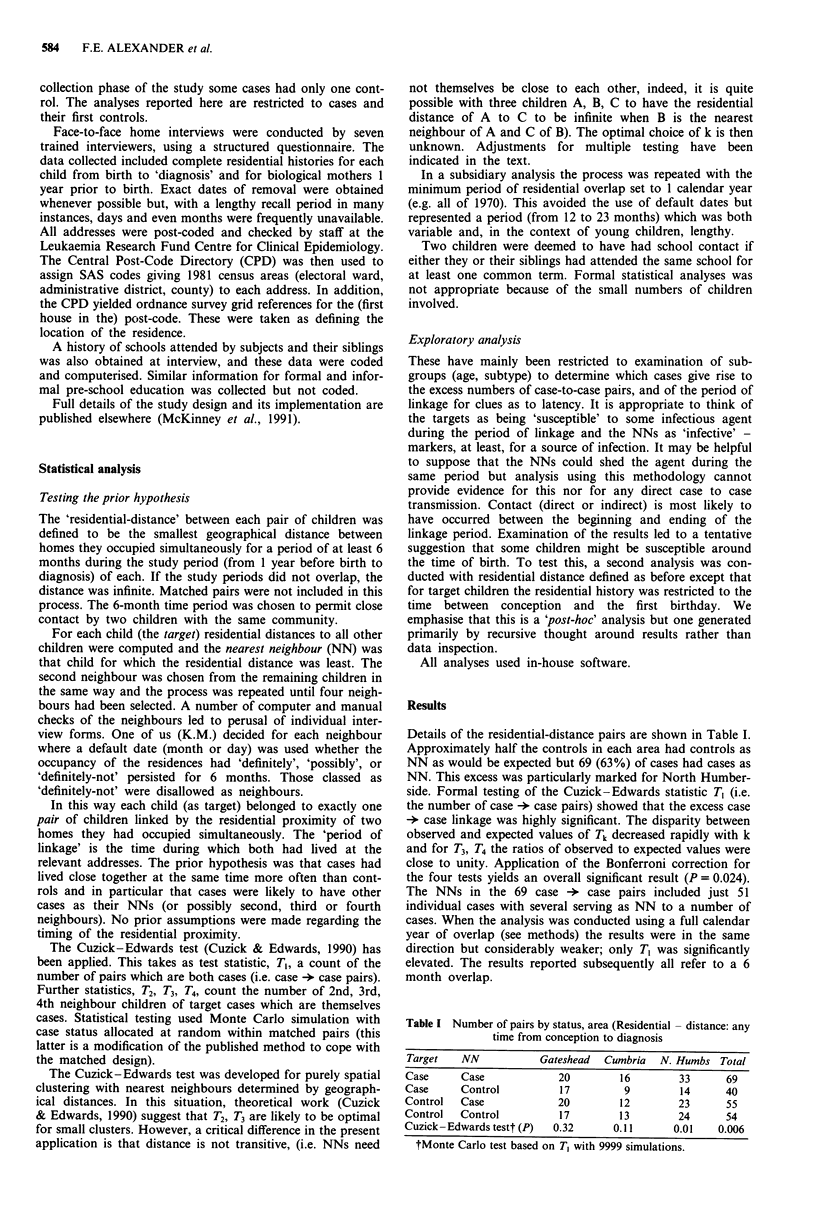
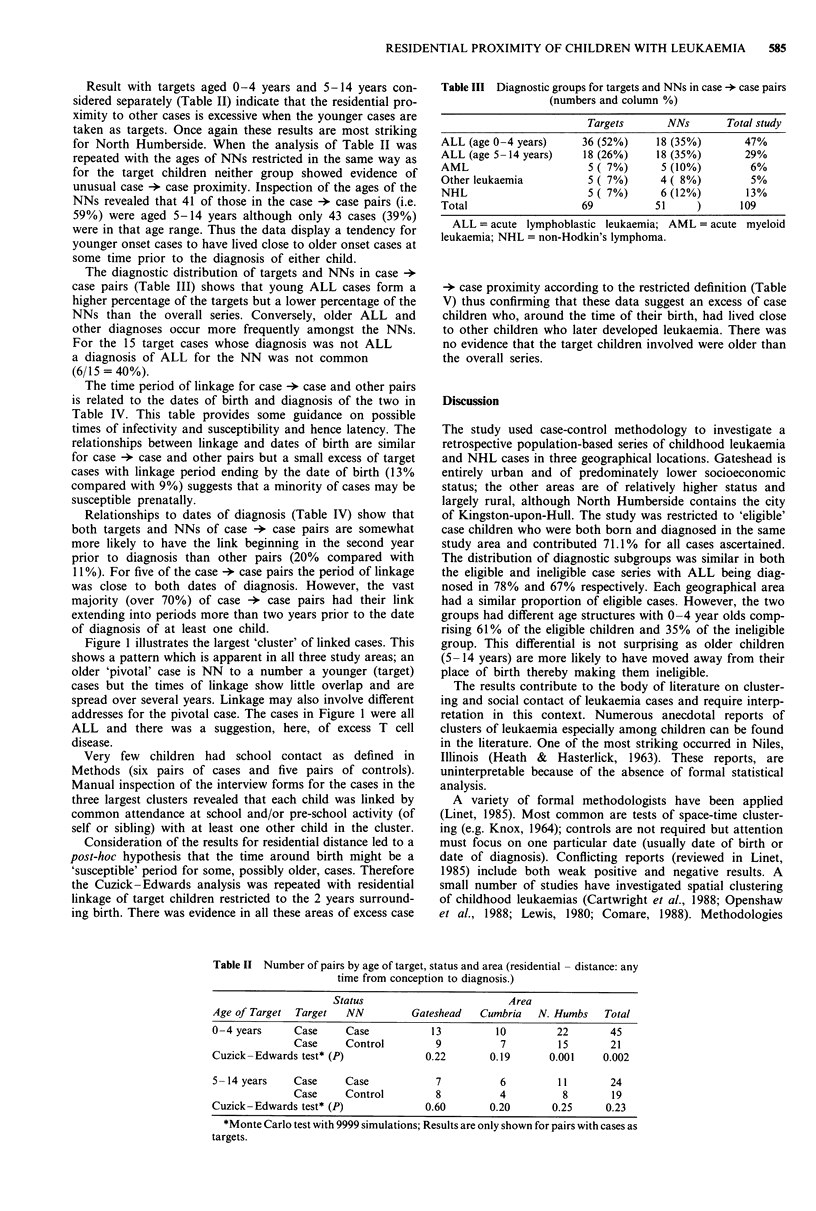
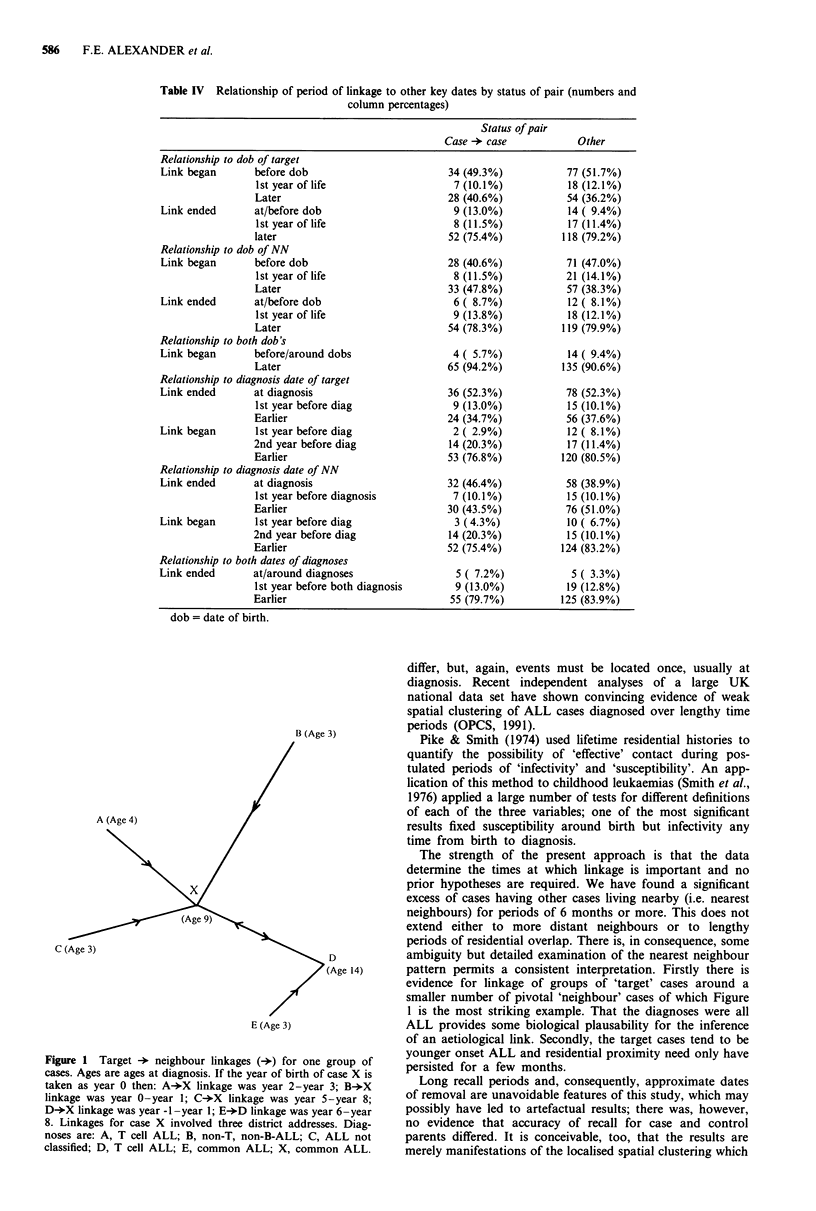
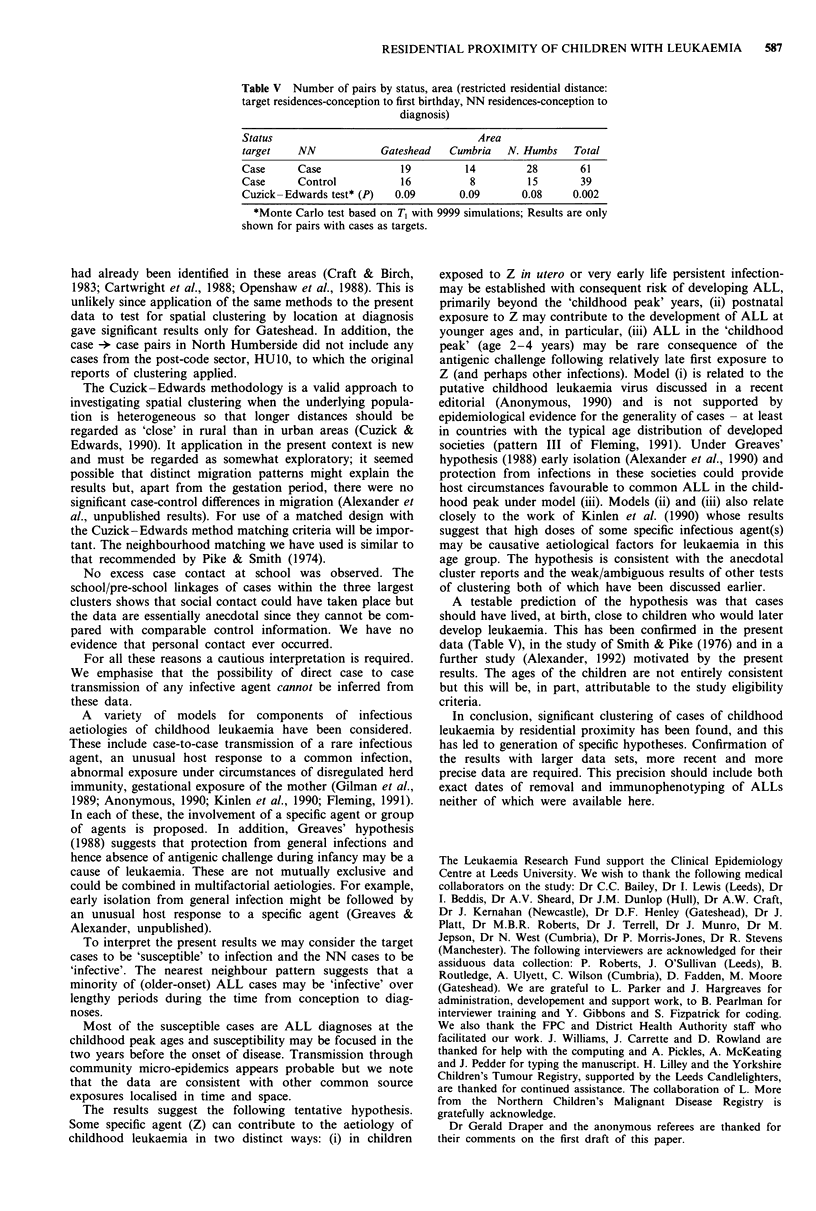
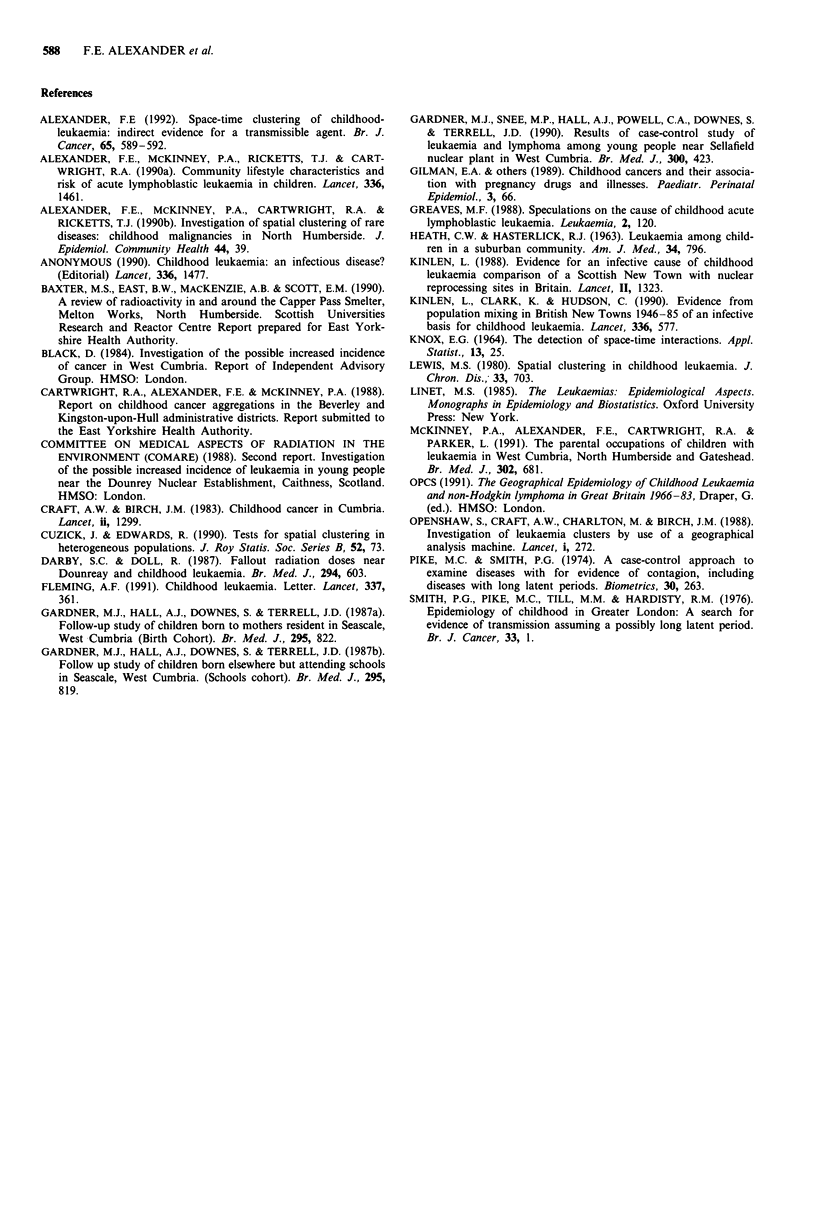
Selected References
These references are in PubMed. This may not be the complete list of references from this article.
- Alexander F. E., Ricketts T. J., McKinney P. A., Cartwright R. A. Community lifestyle characteristics and risk of acute lymphoblastic leukaemia in children. Lancet. 1990 Dec 15;336(8729):1461–1465. doi: 10.1016/0140-6736(90)93176-p. [DOI] [PubMed] [Google Scholar]
- Alexander F. E. Space-time clustering of childhood acute lymphoblastic leukaemia: indirect evidence for a transmissible agent. Br J Cancer. 1992 Apr;65(4):589–592. doi: 10.1038/bjc.1992.119. [DOI] [PMC free article] [PubMed] [Google Scholar]
- Alexander F., Cartwright R., McKinney P. A., Ricketts T. J. Investigation of spacial clustering of rare diseases: childhood malignancies in North Humberside. J Epidemiol Community Health. 1990 Mar;44(1):39–46. doi: 10.1136/jech.44.1.39. [DOI] [PMC free article] [PubMed] [Google Scholar]
- Craft A. W., Birch J. M. Childhood cancer in Cumbria. Lancet. 1983 Dec 3;2(8362):1299–1299. doi: 10.1016/s0140-6736(83)91166-2. [DOI] [PubMed] [Google Scholar]
- Darby S. C., Doll R. Fallout, radiation doses near Dounreay, and childhood leukaemia. Br Med J (Clin Res Ed) 1987 Mar 7;294(6572):603–607. doi: 10.1136/bmj.294.6572.603. [DOI] [PMC free article] [PubMed] [Google Scholar]
- Gardner M. J., Hall A. J., Downes S., Terrell J. D. Follow up study of children born elsewhere but attending schools in Seascale, West Cumbria (schools cohort). Br Med J (Clin Res Ed) 1987 Oct 3;295(6602):819–822. doi: 10.1136/bmj.295.6602.819. [DOI] [PMC free article] [PubMed] [Google Scholar]
- Gardner M. J., Hall A. J., Downes S., Terrell J. D. Follow up study of children born to mothers resident in Seascale, West Cumbria (birth cohort). Br Med J (Clin Res Ed) 1987 Oct 3;295(6602):822–827. doi: 10.1136/bmj.295.6602.822. [DOI] [PMC free article] [PubMed] [Google Scholar]
- Gardner M. J., Snee M. P., Hall A. J., Powell C. A., Downes S., Terrell J. D. Results of case-control study of leukaemia and lymphoma among young people near Sellafield nuclear plant in West Cumbria. BMJ. 1990 Feb 17;300(6722):423–429. doi: 10.1136/bmj.300.6722.423. [DOI] [PMC free article] [PubMed] [Google Scholar]
- Greaves M. F. Speculations on the cause of childhood acute lymphoblastic leukemia. Leukemia. 1988 Feb;2(2):120–125. [PubMed] [Google Scholar]
- Kinlen L. J., Clarke K., Hudson C. Evidence from population mixing in British New Towns 1946-85 of an infective basis for childhood leukaemia. Lancet. 1990 Sep 8;336(8715):577–582. doi: 10.1016/0140-6736(90)93389-7. [DOI] [PubMed] [Google Scholar]
- Kinlen L. Evidence for an infective cause of childhood leukaemia: comparison of a Scottish new town with nuclear reprocessing sites in Britain. Lancet. 1988 Dec 10;2(8624):1323–1327. doi: 10.1016/s0140-6736(88)90867-7. [DOI] [PubMed] [Google Scholar]
- Lewis M. S. Spatial clustering in childhood leukemia. J Chronic Dis. 1980;33(11-12):703–712. doi: 10.1016/0021-9681(80)90057-0. [DOI] [PubMed] [Google Scholar]
- McKinney P. A., Alexander F. E., Cartwright R. A., Parker L. Parental occupations of children with leukaemia in west Cumbria, north Humberside, and Gateshead. BMJ. 1991 Mar 23;302(6778):681–687. doi: 10.1136/bmj.302.6778.681. [DOI] [PMC free article] [PubMed] [Google Scholar]
- Openshaw S., Craft A. W., Charlton M., Birch J. M. Investigation of leukaemia clusters by use of a Geographical Analysis Machine. Lancet. 1988 Feb 6;1(8580):272–273. doi: 10.1016/s0140-6736(88)90352-2. [DOI] [PubMed] [Google Scholar]
- Pike M. C., Smith P. G. Case-control approach to examine diseases for evidence of contagion, including diseases with long latent periods. Biometrics. 1974 Jun;30(2):263–279. [PubMed] [Google Scholar]
- Smith P. G., Pike M. C., Till M. M., Hardisty R. M. Epidemiology of childhood leukaemia in greater london: A search for evidence of transmission assuming a possibly long latent period. Br J Cancer. 1976 Jan;33(1):1–8. doi: 10.1038/bjc.1976.1. [DOI] [PMC free article] [PubMed] [Google Scholar]


